*NURSING > EXAM > NR 566 Midterm exam study guide / NR566 midterm guide (latest 2020/2021) complete (All)
NR 566 Midterm exam study guide / NR566 midterm guide (latest 2020/2021) complete
Document Content and Description Below
MITERM- NR566 1 Know what meds you would give for asthma and COPD (LABA and intermittent use) ⦁ LABA- indacaterol (Arcapta). Indacaterol is a once-daily long-acting bronchodilator that has an onse... t of 5 minutes and a duration of 24 hours ⦁ FORMOTEROL/ SALMETEROL/ INDACATEROL ⦁ What to do when a patient calls you with hypoglycemia ⦁ How many gms of carb is needed during hypoglycemic episode- 15 what to tell patient to do for low blood sugar ⦁ how many mcg of dietary intake of iodine ⦁ Dietary iodine of about 100 to 150 mcg/d is required for normal thyroid hormone production. ⦁ alendronate (Fosamax) patient education- osteoporosis ⦁ PO meds should be taken first thing in the morning, at least 30 mins prior to medications. ⦁ Take it with 8oz plain water ⦁ Mineral water, coffee, OJ, and other beverages greatly reduce absorption. ⦁ Remain upright for least 30 mins after taking meds, which allows for passage out of the stomach and minimizes the risk for esophageal irritation. ⦁ GI distress and dyspepsia are the most common s/e's. if needed take aluminum and magnesium containing anatacids may be taken more than 2 hours fosomax. ⦁ Patients should eat a diet that has calcium and vitamin D ⦁ what medication decreases the T4 and the answer was Carbamazepime/ drug increases t4 (carbamazepine) ⦁ First choice for hypertension – which diuretic ⦁ thiazide-type diuretic has been typically chosen because in the landmark Chlorothiazide (Diuril) Chlorthalidone. Hydrochlorothiazide (Microzide) Indapamide. Metolazone. ⦁ Besides hypertension, BB are indicated for (I selected MI) Angina/ HTN/ MI prophylaxis/ glaucoma / migraine prophylaxis 10 Mechanism of action of Theophylline ⦁ Treats asthma (bronchodilator) ⦁ Work directly by an unknown mechanism believed to be mediated by selective inhibition of specific phosphodiesterases. This, in turn, produces an increase in cAMP, which then leads to bronchial smooth muscle and pulmonary vessel relaxation. ⦁ Theophylline and caffeine have an impact on most of the major body systems. They are powerful CNS stimulants, often causing insomnia and excitability. Although both drugs have cardiovascular effects, theophylline has a greater effect on the cardiovascular system. Theophylline directly stimulates the myocardium and increases myocardial contractility and heart rate. By relaxing vascular smooth muscle, theophylline dilates the coronary, pulmonary, and systemic blood vessels. 11 What should you test a patient c/o muscle pain, on atorvastatin ⦁ For all reductase inhibitors, muscle tenderness or pain may indicate a serious problem that may require discontinuance of the drug. ⦁ patient C/O muscle pain on atorvastin: check cK level. ⦁ 7 yo with pneumonia, what to give if already on amoxicillin ⦁ high-dose amoxicillin (90 mg/kg daily, divided in two doses) is the drug of choice for 7 to 10 days of outpatient treatment (Bradley et al, 2011)). If highly resistant pneumococci are in the community, the practitioner may choose between IV or IM ceftriaxone (50 mg/kg in one daily dose) or cefotaxime (150 mg/kg/d every 8 hours) followed by appropriate oral therapy after 1 or 2 doses ⦁ What to give for high cholesterol if cannot take statins – name of medication ⦁ Nicotinic acid (niacin) was always touted as effective in lowering total cholesterol and triglyceride levels and raising HDL levels ⦁ Which inhaler to give on asthma exacerbation ⦁ Ipratropium is an inhaled anticholinergic that may be used in combination with albuterol to treat asthma exacerbation in the emergency department (NAEPP, 2007). Hospital admission may be avoided by the addition of ipratropium to the treatment regimen in cases of exacerbation seen in the clinic or emergency department ⦁ Nicotine replacement drugs– bupropion should be avoided with what? ⦁ Bupropion is contraindicated in patients with seizure disorders, bulimia, and anorexia nervosa and within 14 days of the use of monoamine oxidase inhibitors (MAOIs). ⦁ Bupropion should not be used in patients with a history of stroke, brain tumor, brain surgery, or history of closed head injury. ⦁ Bupropion should be used with caution in patients with hepatic cirrhosis, with the dose decreased to 150 mg every other day. ⦁ The concurrent use of bupropion (Zyban) and Wellbutrin is contraindicated. Risk of suicide ideation and suicidality in children, adolescents, and young adults. Zyban is not approved for smoking cessation in children under 18 years of age. Patients prescribed Zyban should be monitored closely for signs of suicide ideation when treatment is started. ⦁ INH - risk for liver toxicity ⦁ INH has a Black-Box Warning regarding the development of severe and sometimes fatal hepatitis, even after many months of treatment. ⦁ .Increased risk for hepatitis is associated with daily alcohol use, chronic liver disease, and IV drug use. Black and Hispanic women, as well as any woman during the postpartum period who takes INH, may have increased risk of developing fatal hepatitis. nitro sublingual ⦁ All patients taking INH should have monthly symptom reviews to screen for hepatitis. Symptoms to screen for include unexplained anorexia, nausea, vomiting, dark urine, icterus, rash, persistent paresthesias of hands or feet, fatigue, weakness, fever longer than 3 days, or abdominal tenderness especially in the right upper quadrant. ⦁ Liver enzymes should be measured in patients over age 35 years prior to starting INH and then periodically throughout treatment. ⦁ They should report all flu-like illness immediately and see their health-care provider at least monthly during treatment. ⦁ Angina patient should be on ASA- aspirin ⦁ Atenolol, metoprolol, nadolol, and propranolol are indicated for long-term management of angina ⦁ Angina and diabetic should be on what ⦁ Which medication to take for SVT ⦁ Verapamil might be chosen for patients with supraventricular tachycardia who also have angina. ⦁ Type 1 CCBs (calcium channel blockers) are useful in treating selected supraventricular tachycardias because they slow AV nodal conduction. Verapamil (80 to 120 mg orally) can be used to terminate the rhythm. Conversion usually occurs in about 1 hour. Diltiazem (40 to 80 mg orally) can also be tried. Prophylaxis with verapamil (240 to 480 mg/d) is effective for patients with paroxysmal supraventricular tachycardia (PSVT) ⦁ MOA of nitroglycerine sublingual ⦁ Nitroglycerin (NTG) and its analogues act largely by providing more nitric oxide (NO) to vascular endothelium and arterial smooth muscle, resulting in vasodilation (Fig. 16-5). All parts of the vascular system, from larger arteries to large veins, relax in response to nitrates. ⦁ Sublingual absorption is dependent on salivary secretion. Dry mouth (including drug-induced) decreases absorption. ⦁ The sublingual route avoids hepatic first-pass effect and is preferred for achieving a rapid blood level. ⦁ Goal for HgA1C when on tx; 7mg/dL ⦁ Glucagon route; How glucagon is given ⦁ Glucagon is well absorbed after parenteral administration. (IM) 23 MOA of insulin ⦁ once insulin arrives to the receptors, it creates changes within the cell membrane that result in translocation of certain proteins, such as glucose transporters from sequestered sites within the cell to the cell surface. ⦁ Insulin promotes the storage of fat as well as glucose and influences cell growth and metabolic functions in a wide variety of tissues. ⦁ Insulin acts on the liver to increase storage of glucose as glycogen and resets the liver after food intake by reversing the amt of catabolic activity. ⦁ Insulin reduces the circulation of free fatty acids and promotes storage of triglycerides in adipose tissue, done by the suppression of cAMP production and dephospherylation of the lipases in fat cells. ⦁ stages of asthma adults (>12yrs) ⦁ Mild intermittent asthma: Symptoms occur less often than twice a week and the patient is asymptomatic between exacerbations; nighttime symptoms occur less than twice a month; and peak expiratory flow (PEF) is greater than 80% predicted. The use of short- acting beta2 agonists (SABA) should be less than twice a week, unless used for exercise- induced bronchospasm (EIB). ⦁ Mild persistent asthma: Symptoms occur more often than twice a week but less often than once a day and exacerbations may affect activity; nighttime symptoms occur 3 to 4 times a month; and PEF is greater than 80% predicted. Patients with mild persistent asthma may use their short-acting beta2 agonists more than twice a week but not daily, and not more than once daily. ⦁ Moderate persistent asthma: The patient is having daily symptoms; requires daily use of a beta2 agonist; exacerbations affect normal activity; nighttime symptoms occur more often than once a week; and PEF is greater than 60% to less than 80%. ⦁ Severe persistent asthma: The patient has some degree of symptoms all the time; extremely limited physical activity and frequent exacerbations; frequent nighttime symptoms, often 7 days a week; and decreased lung function (PEF less than 60% predicted). Table 30-1 outlines the classifications of asthma severity in patients aged 12 years or older. stages of asthma children (<12 yrs) ⦁ Mild intermittent asthma: Symptoms occur less often than twice a week and the patient is asymptomatic between exacerbations. Children aged 0 to 4 years have no nighttime symptoms, and children aged 5 to 11 years have nighttime symptoms less than twice a month and PEF is greater than 80% predicted. The use of short-acting beta2 agonists should be less than twice a week, unless using for EIB. Exacerbations requiring oral systemic corticosteroids occur no more than once a year. ⦁ Mild persistent asthma: Symptoms occur more often than twice a week but less often than once a day and exacerbations may affect activity. In children aged 0 to 4 years, nighttime symptoms occur 1 to 2 times a month, and in children aged 5 to 11 years, nighttime symptoms occur 3 to 4 times a month; PEF is greater than 80% predicted. Patients with mild persistent asthma may use their short-acting beta2 agonists more than twice a week but not daily, and not more than once daily. Children younger than age 4 years with mild persistent asthma have more than two exacerbations in 6 months requiring systemic steroids or four episodes of wheezing in a year lasting more than a day and risk factors for persistent asthma. Children aged 5 to 11 with mild persistent asthma have exacerbations 2 or more times a year. ⦁ Moderate persistent asthma: The child is having daily symptoms; requires daily use of a beta2 agonist; and exacerbations affect normal activity. In children aged 4 years or younger, nighttime symptoms occur 3 or 4 times a month, and in children aged 5 to 11 years nighttime symptoms occur more than once a week but not nightly; PEF is greater than 60% to less than 80%. Children with moderate persistent asthma have exacerbations 2 or more times a year. ⦁ Severe persistent asthma: The patient has some degree of symptoms all the time; extremely limited physical activity; frequent nighttime symptoms (more than once a week in children younger than age 4 years and in older children often occurring 7 days a week); and decreased lung function (PEF less than 60% predicted). Children aged 5 to 11 with severe persistent asthma have exacerbations 2 or more times a year. ⦁ what to give pregnant pt with TB (niacin) ⦁ know what hgA1c percent is equal to blood sugar/ levels [Show More]
Last updated: 2 years ago
Preview 1 out of 30 pages
.png)
Buy this document to get the full access instantly
Instant Download Access after purchase
Buy NowInstant download
We Accept:

Reviews( 0 )
$10.00
Can't find what you want? Try our AI powered Search
Document information
Connected school, study & course
About the document
Uploaded On
Mar 25, 2021
Number of pages
30
Written in
Additional information
This document has been written for:
Uploaded
Mar 25, 2021
Downloads
0
Views
68

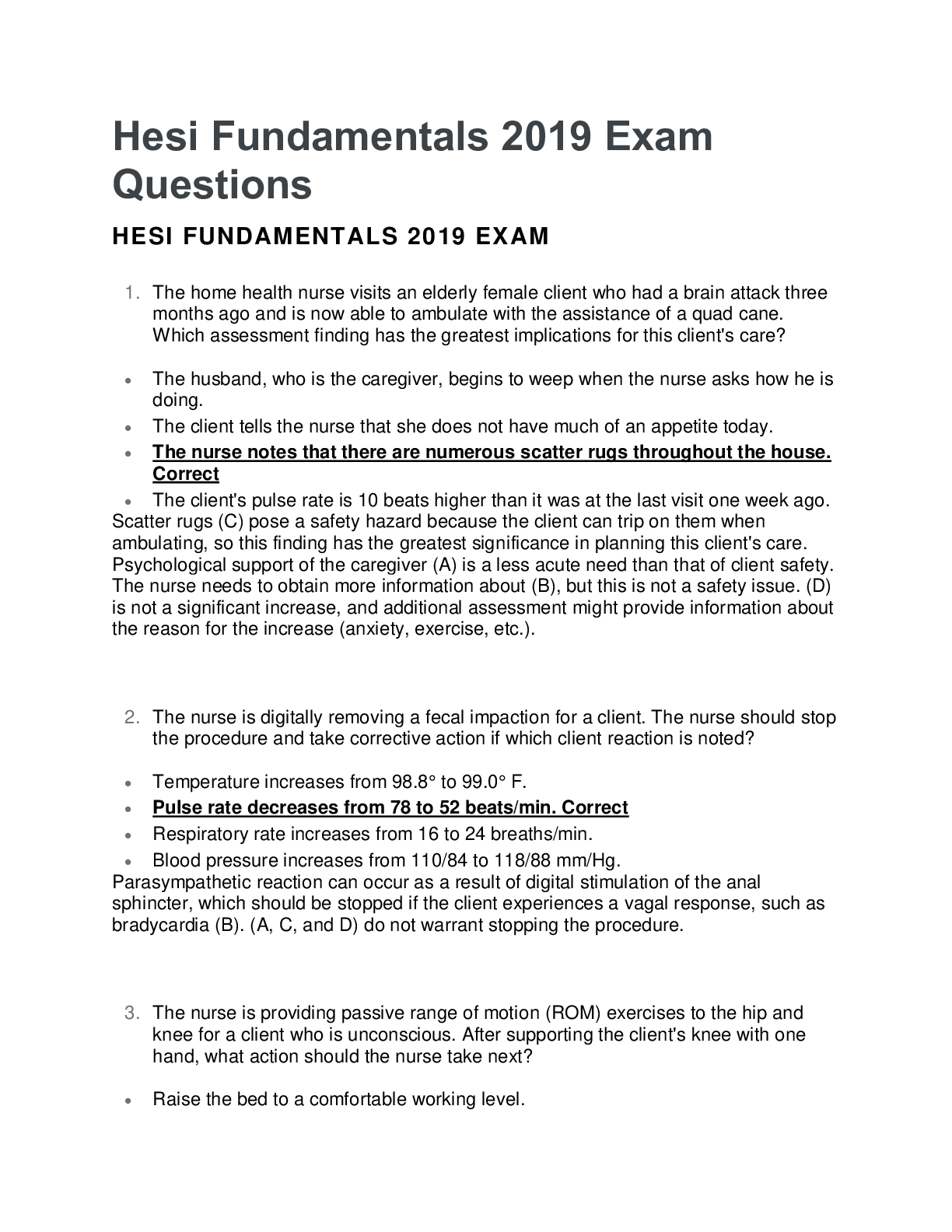
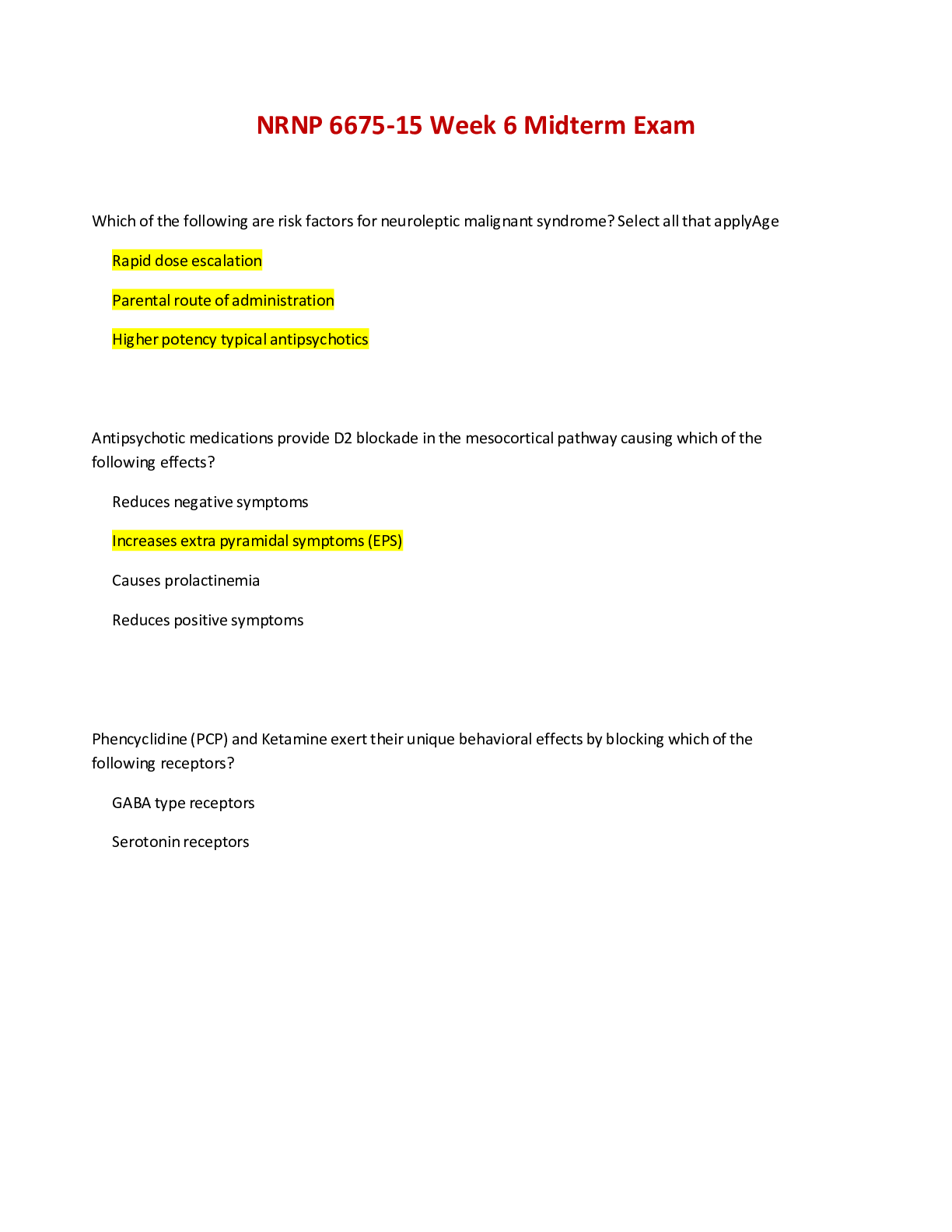
.png)
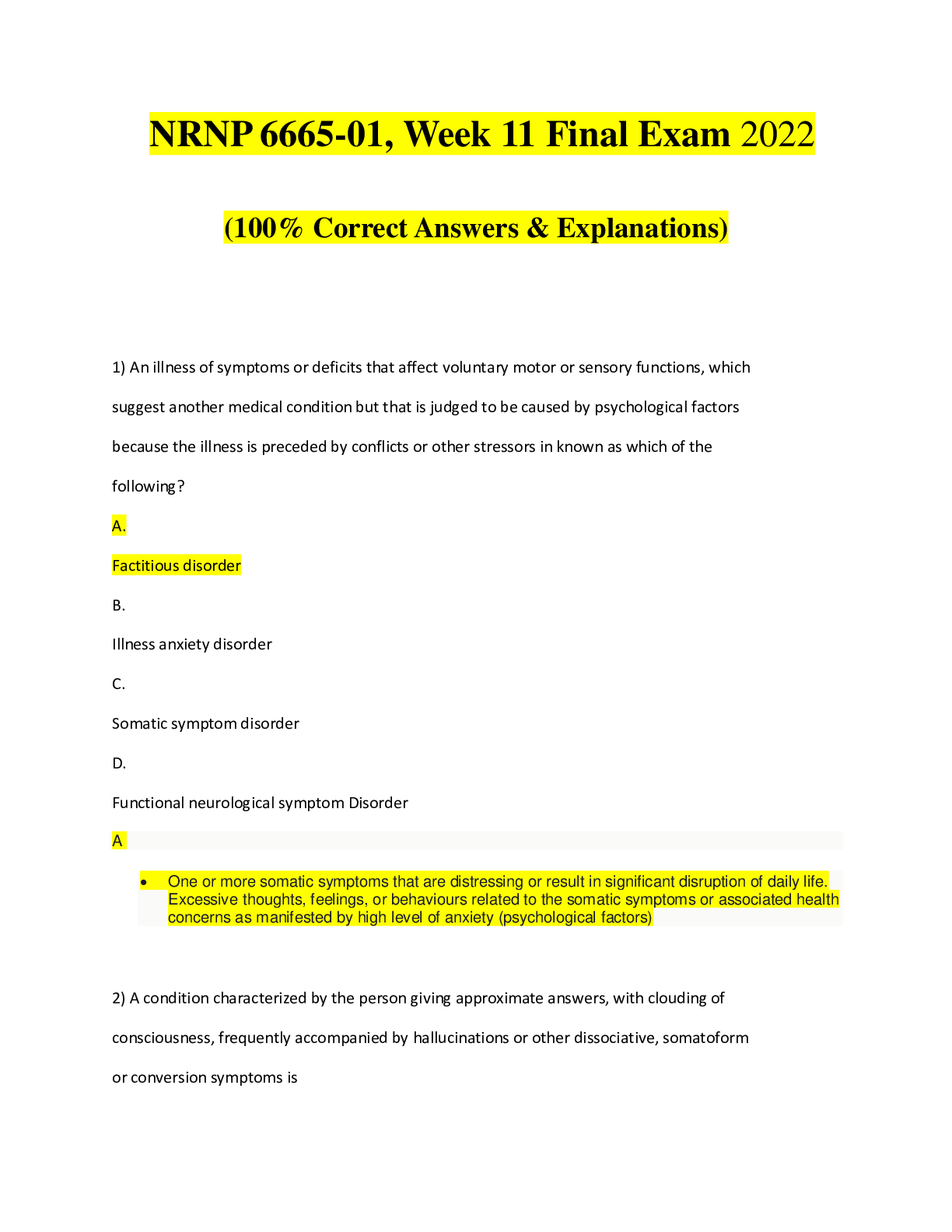
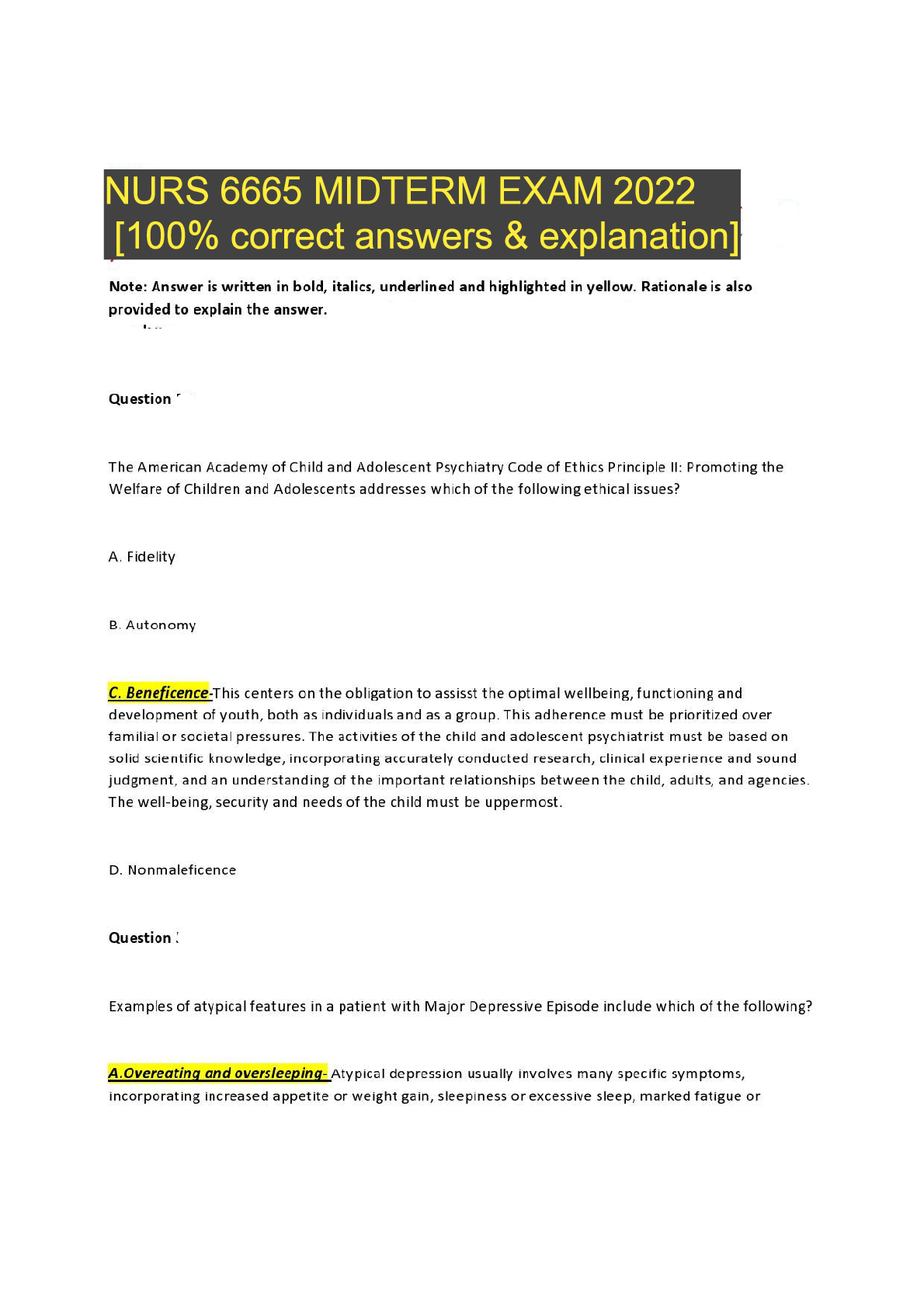
.png)
_removed.png)
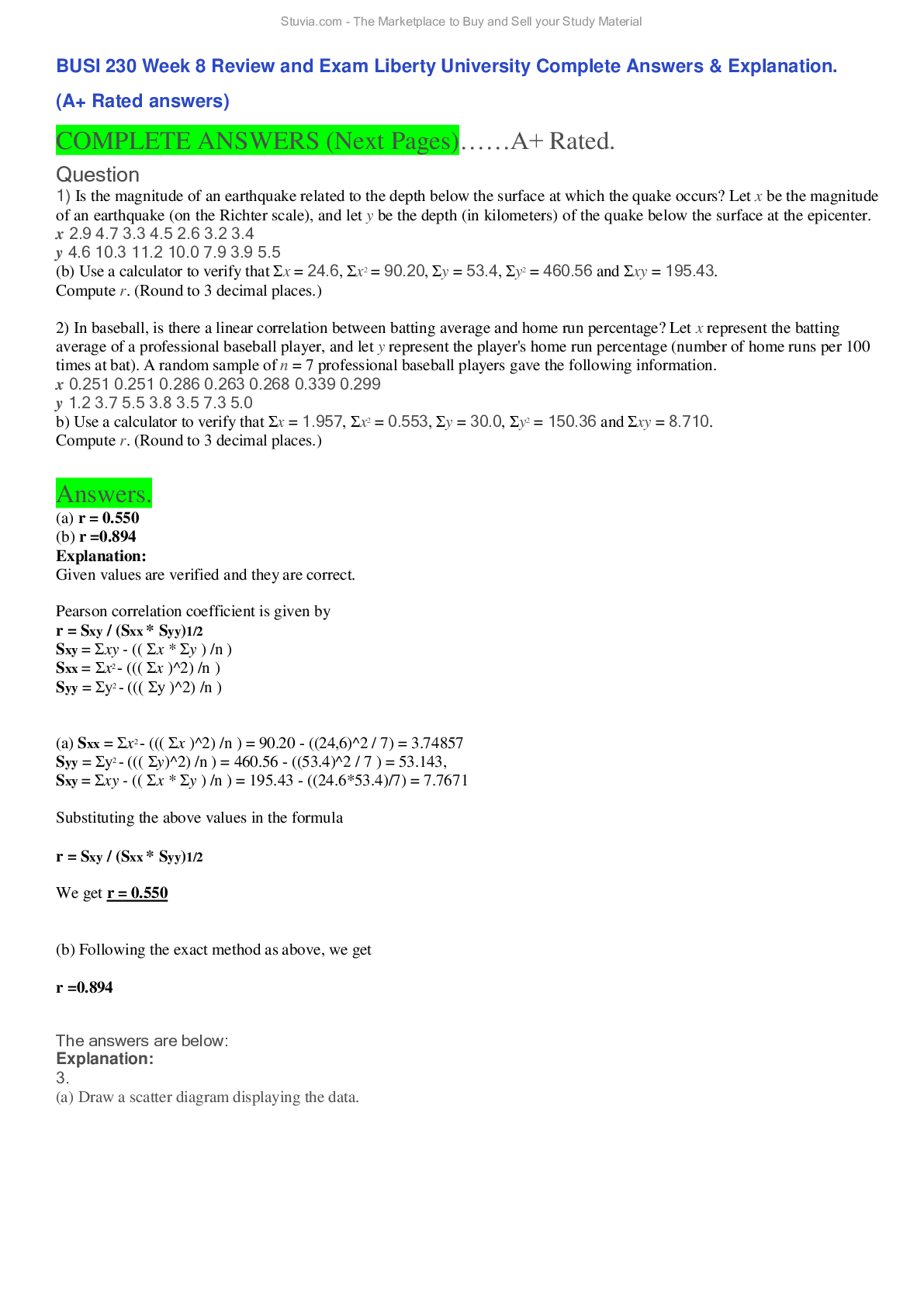
 (1)_removed.png)
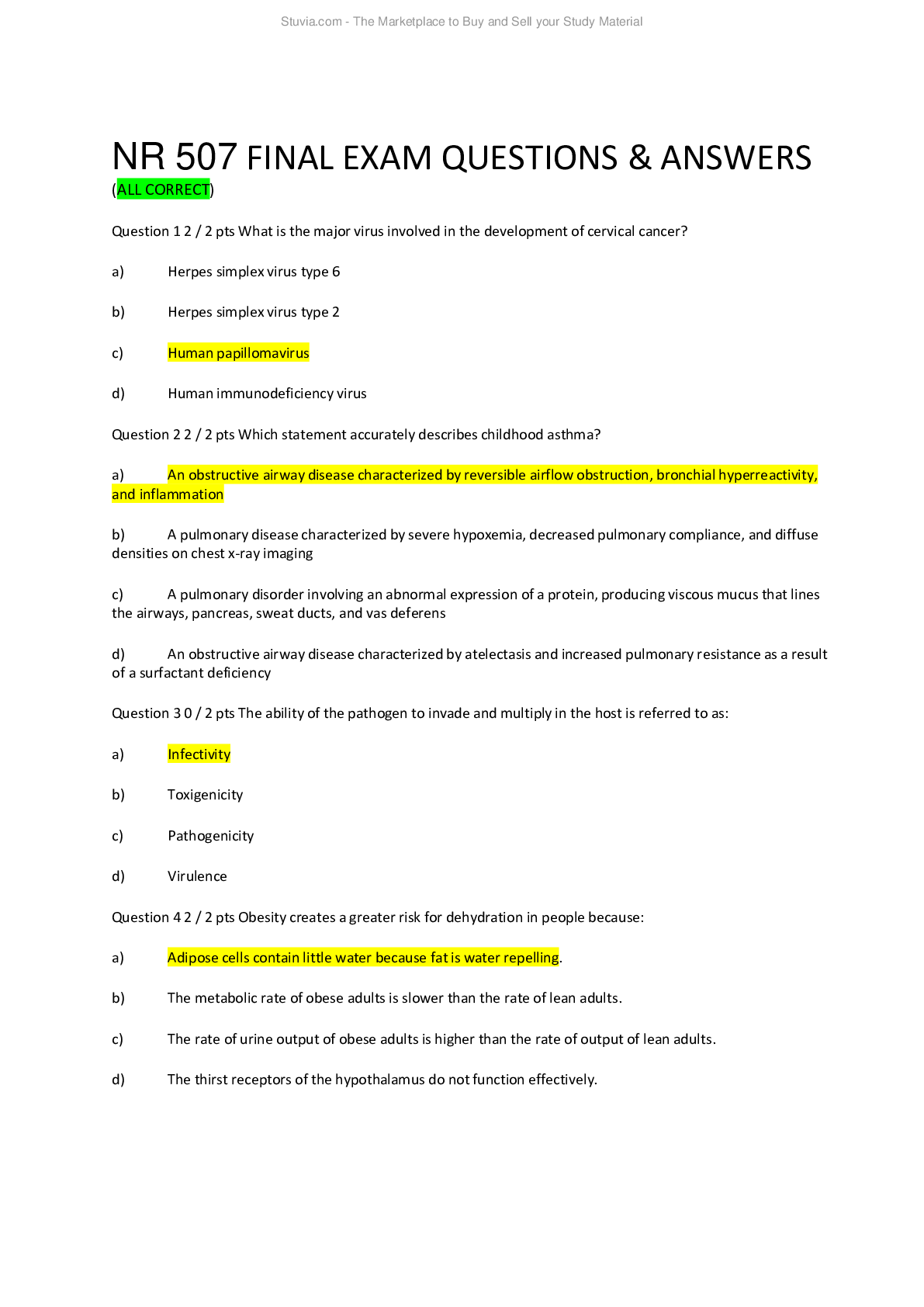
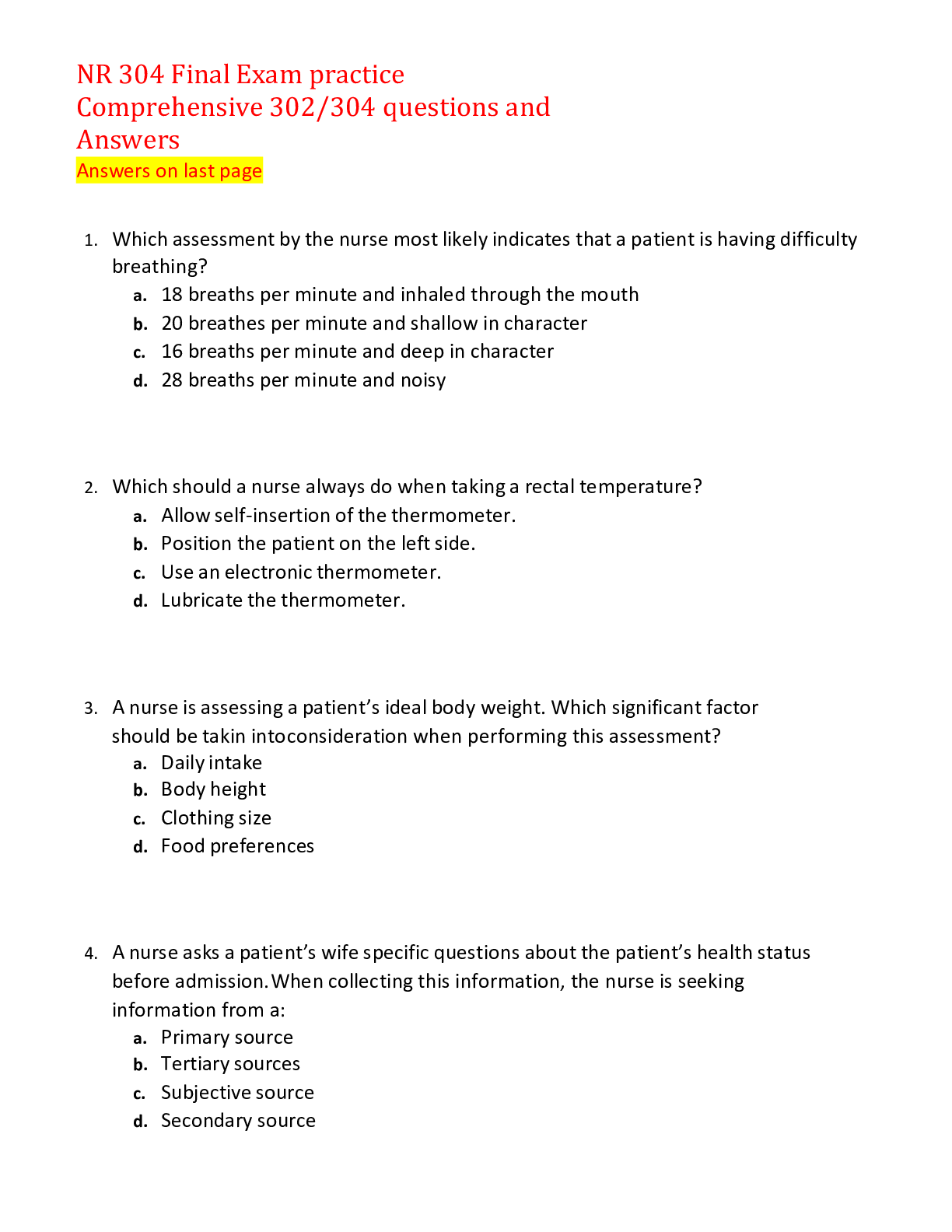
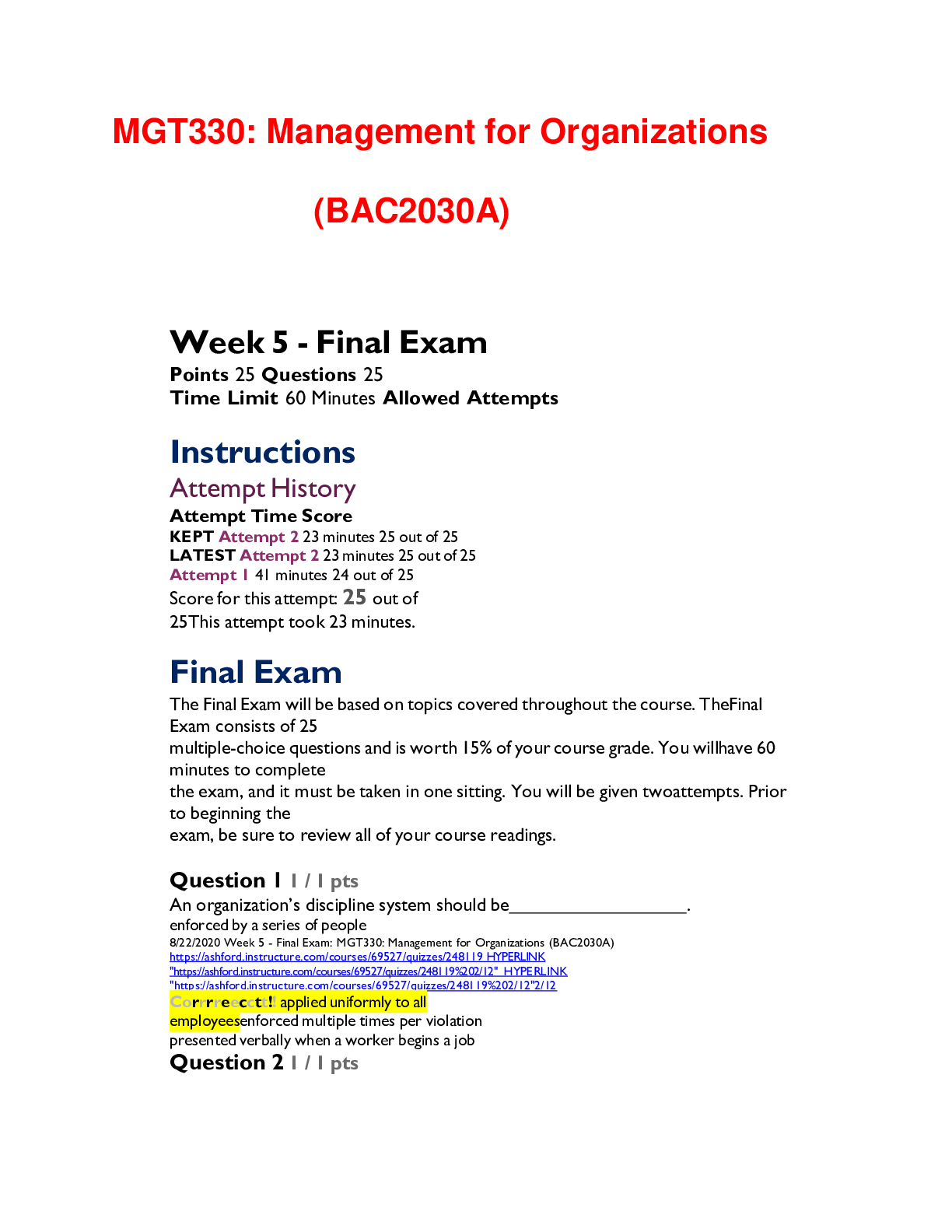



.png)




